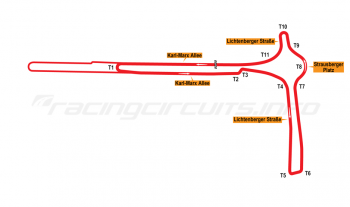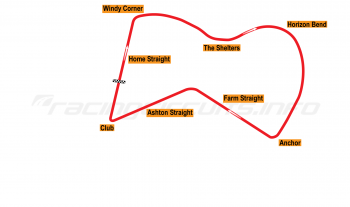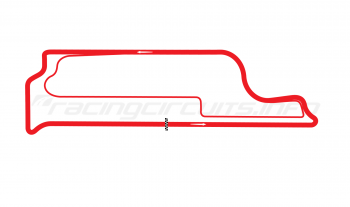Pocono Raceway
Circuit Overview
Pocono Raceway is one of the more unusual venues on the NASCAR and latterly IndyCar trail; a family-owned venue that is fiercely independent and has a loyal following of fans as a result. 'The 'Tricky Triangle' is, as its nickname suggests, a difficult track to master, quite unlike any other in north America, with long straights and three banked corners each with their own unique characteristics.
Often overlooked is the complex of road courses within the confines of the oval which see regular use for motorcycle racing, club events and track days. Outside racing Pocono is used throughout the year by the Stock Car Experience and the Bertil Roos Driving School.
Pocono continues to host a wide range of regional and club level motorsport alongside its major NASCAR event, a 400 mile race in July.
Circuit History
Pocono Raceway is unconventional in many ways but perhaps we should expect nothing else from a venue whose founder was anything but the conventional track owner. Joe 'Doc' Mattioli was a successful Philadelphia dentist who quit his prosperous practice one day in 1960 in order to enjoy a more adventurous life, along the way amassing a small fortune in property deals in the Pocono resort area in northern Pennsylvania. A chance encounter in an airport lounge was to begin a forty year association with motor racing.
"One day when I'd flown into the Poconos, an old gentleman I'd met in the airport tried to con me into investing in a project up here," explained Doc back in 2001. "Just to get rid of him, I gave him my card and told him to let me know when he had his next meeting. Lo and behold, six weeks later he called me, I came up and I got involved.
"It's been said that I got in on the ground floor but that's not true - there wasn't any ground! I had to buy it. They'd optioned the land but they didn't have any money so I had to guarantee the mortgage and ended up paying it off.
"The track wasn't my idea, I just got sucked in through the back door because I knew it was a good buy on the land. All the money I'd made off my other Pocono businesses went into the racetrack."
And so it was that work began in 1965 - the official 'ground breaking ceremony' was held on 8 July - and the first stage of the facility was completed in October 1968. At first Pocono International Raceway comprised a three-quarter mile oval and a drag strip (which was to double as the main straight for the full, 2.5-mile 'tri-oval'). A 1.8-mile road course was added in 1969 and in early 1970 the work on the full sized oval was started.
The one-of-a-kind superspeedway boasted corners modelled after other famous ovals: Turn One (14 degree banking) was inspired by the now defunct Trenton Speedway; Turn Two (also known as "The Tunnel Turn") is like Indianapolis Motor Speedway (9 degree banking); and Turn 3 (6 degree banking) borrows from the relatively flat turns of the Milwaukee Mile. The varied nature of the banking means this is a track where good setups are at a premium and often require compromise to achieve speed.
USAC Championship Cars arrive
Workers were still applying the final touches when the USAC Championship Cars rolled into the facility for the first 500 mile race, sponsored by the Schaefer brewing company. On 19 June 1971, Rose Mattioli, Doc's wife who was ever present at Pocono, cut the ribbon to open the track for practice. Two hours later Jim Malloy's Eagle-Ford made a few, tentative laps for the benefit of the television cameras. Official qualifying trials for the 500 took place on the weekend of 26-27 June, Mark Donohue qualifying on pole in a Penske-entered McLaren M16-0ffenhauser.
The race itself was on 4 July and Donohue was in strong form, leading the majority laps before being challenged in the final stages by the Colt-Ford of Joe Leonard. A late yellow flag caution period bunched the field and when the green 'all-clear' was given, the Colt flashed by the McLaren through Turn Two. For three laps Leonard remained ahead, but he could not fend off the blue McLaren when Donohue surged by on the main straight to take the win by just 1.6 seconds after 500 miles of close racing. The crowd went wild with excitement, invading the pit area after the race.
USAC racing was to be an early mainstay of the calendar at Pocono, hosting 500 mile races right through to the split with the team owners and formation of CART in 1981, continuing under this new banner until 1989. Road racing was also popular here too; the SCCA remains a regular on the various road courses, while the IMSA Camel GT sportscars were also visitors in the 1980s. The majority of the road races ran in a clockwise direction, opposite to the oval course.
NASCAR makes its debut
In 1974, the circuit was granted the first of what quickly became two NASCAR events each year. In NASCAR supremo Bill France Sr, the Mattiolis found a close ally and personal friend; in truth the 1970s were very difficult periods of financial instability. Pocono Raceway's very existence was threatened by the economic and energy crisis and by the end of the decade, the Mattiolis seriously considered selling up. Only the intervention of the Bill France Sr changed their minds, convincing them to stick it out and personally attending the races for two years in a row as a show of solidarity. Shortly thereafter he and his son, Bill Jr., gave Pocono a second NASCAR race and the circuit was able to build a strong future.
Into the mid-1980s, the first changes began to occur, when a revised road course was opened, which by passed the old quarter-mile oval altogether, with a new stretch of tarmac leading from the start-finish straight and rejoined the old road course at the esses. At the same time, a new south course was established, inside oval Turn One. This could be combined with the main road course to form an alternate layout bypassing the final oval turn altogether. This was used by the SCCA for a number of years until concerns over run-off areas saw them switch back to the original road course, albeit with a chicane ahead of the final banked turn.
By the early 1990s, the facility was looking generally careworn. The track surface was extremely bumpy – so much so that the IndyCars dropped it from their calendar – and safety measures did not match up to modern expectations. This was illustrated by some sizeable shunts, not least for Davey Allison in 1992, when a tangle on the straightaway sent his car somersaulting violently into the infield, landing on top of a guardrail. Miraculously, Davey survived the crash with a severe concussion, along with a broken arm, wrist, and collar bone.
Pocono's refurbishment begins
Having quietly bought out the rest of the stockholders, the Mattioli's had a free hand to begin an ambitious programme of continual investment. They planned to spend around $3 million each year on improvements, effectively tearing Pocono Raceway down piece by piece and starting from scratch.
The first tangible changes came with the installation of a new 1.4 mile 'East' road course in 1991 and a programme of pit and paddock upgrades quickly followed. This involved the removal of the three-quarter mile oval altogether, while the track itself had many upgrades, including new crash walls and new pavement to a unique garage area that put the fans at the centre of the action.
Among the paddock improvements was the addition of a 150-site motor home park for the participants, 124 of which have water, sewer and electricity. Meanwhile, special viewing areas in front of the garages were installed and a midway lined with tall Blue Spruce trees and 200 picnic tables was created. Ensuring all needs were catered for, all of the old 375 toilets were replaced by 'Long John', the biggest toilet facility in the world boasting 1000 stalls to ensure there would be no queuing.
The track was resurfaced in 1995 and again in 2011, in between receiving SAFER barriers on the infield. The road courses received plenty of attention, including a complete re-grading and resurfacing in 2013. A new infield extension to the East and South courses was added, while all kerbing was replaced to FIM standards. The changes allow all courses to be run in either direction, creating a total of 35 possible layout variations.
An interesting development in 2010 was the installation of a 'solar farm' containing 40,000 solar panels, which satisfies the energy needs for the entire racing complex and and additional 1,000 homes. Upon completion the racetrack became the largest solar-powered sports facility in the world.
IndyCar departs after major crashes
The IndyCar Series returned to Pocono in 2013, as part of a 'triple crown' competition involving the other races at Indianapolis and Auto Club Speedway, reviving a similar competition held between 1971 and 1989. A $1 million bonus was to be paid to a driver who wins all three races in a single season.
In response to the popularity of the triple crown idea, IndyCar announced that the 2014 event would be extended to 500 miles / 200 laps, in what would be the first such length of race at Pocono since the CART IndyCar race in 1989. The race became the fastest 500-mile event in motorsports history when Juan Pablo Montoya was first past the chequered flag at an average speed of 202.402 mph, breaking a record established at Talladega Superspeedway by Mark Martin in a NASCAR race in May 1997.
Sadly, a series of serious collisions and tragedies began to dog the race from 2015 onwards, leading to open speculation about Pocono's suitability for the powerful single-seater series. In the 2015 race, British racer Justin Wilson was struck in the head by the errant nose cone of Sage Karem, after he crashed at Turn 1. Tragically, Wilson died in hospital the next day. Then during the 2018 race, Ryan Hunter-Reay and rookie Robert Wickens collided at the exit of the Tunnel Turn while battling for 3rd. Wickens' car was sent crashing into the catch fencing at huge speed, his car disintegrating as it did so. Wickens survived the crash, but was paralysed from the waist down.
The final straw came in 2019, when Felix Rosenqvist was hospitalised following a five-car collision, leading to Wickens, among others, to publicly call for the series to drop the Pocono race. Although there was no direct announcement by IndyCar, the Pocono race was missing from the 2020 schedule.
Pocono today
'Doc' Mattioli died in 2011 and his wife Rose passed on in 2020 but the track is today is run by the Igdalsky siblings Brandon, Nicholas, and sister Ashley, and cousins Joseph IV and Chase Mattioli, all of whom are third-generation members of the family.
The aim is to continue to develop the facility – not to become the biggest or the richest or the most famous racetrack in the world – but instead to concentrate on being the prettiest, friendliest and cleanest.
Jump onboard
Circuit info
- Pocono Raceway, 1234 Long Pond Road, Long Pond, PA 18334, USA
- +1 717 646-2300
- Email the circuit
- Official website
Rate This Circuit
Votes: 5592
Plan a visit
Get your race tickets!
Brought to you with: 
We've teamed up with Motorsports Tickets to bring you the best deals for Formula One, MotoGP, Le Mans and more.





















































